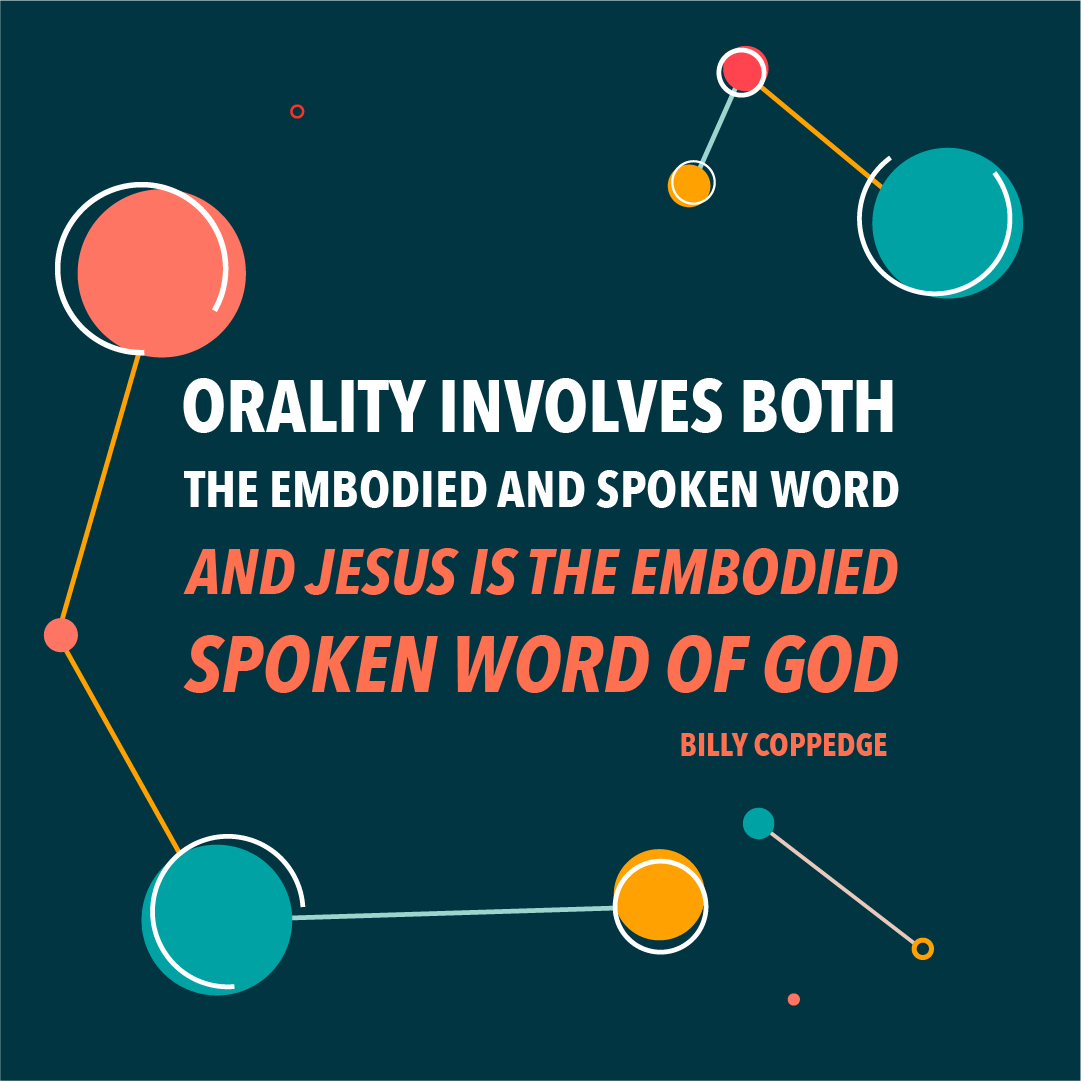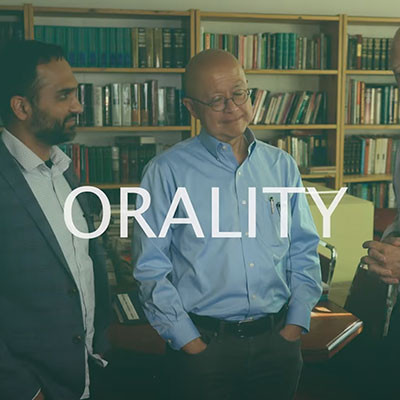There is a common misunderstanding circulating in some mission circles today regarding orality. When the topic surfaces, people will often nod politely about its importance for groups with no or limited literacy skills, emphasize that is not their intended audience, and move on to the next conversation.
However, such a narrow view of orality fails to appreciate the direct line that can be drawn between interpersonal, oral communication and the nature of God and His mission today. Perhaps, we might learn together by coming at this from a different angle.
What are the critical issues in the story of global missions today?
Certainly, we can quickly assemble a formidable list: human sexuality and gender, marriage, family, contextualization amidst glocalization, contemporary marginalization, diasporas and refugees, big technology, systemic poverty, Bible poverty, political systems, climate change, etc. The list could easily keep going. But it is worth asking, what is the common theme that runs through all of these challenges facing the global church today?
VIDEO
What Is Orality?
Lausanne catalysts for orality define the term and explain its embodied significance for missions today.
To answer that question, I’d like to recall an observation that Matthew Niermann made at the Lausanne 2022 leaders’ meetings in NYC. In the midst of a well-crafted presentation and update on the State of the World report, Niermann suggested that the number one question that will shape world realities in 2050 is this: What does it mean to be human?
Niermann’s observation helps us identify the common denominator in every critical issue facing world missions today: human persons. No matter the conflict or context, we cannot talk about the future of missions without talking about personhood.
Ironically, such an observation seems almost simplistic, and we can hear the proverbial exclamation, ‘But, of course!’ Yet if we’re honest, there is a humility to personhood, perhaps born out of our seemingly over-familiarity with our own kind, that causes most of us to run right by the very issue that Niermann suggests could be key to impacting the future world for Christ. If orality has anything to do with person–al communication, then it begs asking the question, what does it mean to be a human person?
In his unique Christological approach to theology, Dennis Kinlaw suggests that any discussion of personhood begins with Jesus. While space limits full exploration, Kinlaw outlines several aspects of personhood, all of which begin in Christ Jesus.
Although slightly technical, establishing these characteristics of personhood have immense relevance, both for Niermann’s critical inquiry and for beginning to recognize the significance of orality as inter-personal communication. Kinlaw begins by noting that persons have an awareness of their own identity. Jesus was conscious of his identity—he was not the Father and not the Spirit.
Second, in spite of being differentiated from his Father and the Spirit, to receive Jesus is to receive the Father, as there is an interconnectivity between persons. Persons always come in webs of relationships.
Third, Jesus models for us the reciprocal nature of personhood, whereby the members of the Holy Trinity continually give of themselves and receive each other into themselves. This co-indwelling within one another is called perichoresis, and Kinlaw summarizes the concept by declaring, ‘The inner life of the Triune Godhead is thus a life of communion in which the three divine persons live from, for, and in one another’ (83).
What is startling is that Kinlaw argues that Jesus is not just exemplifying divine personal relationships, but Jesus is modeling how human personal relationships were intended to work—a perpetual communion of giving and receiving love.
DEVOTIONAL PLAN
We Love Because God First Loved Us
A 10-day plan for drawing closer to the loving heart of God.
Fourth, we see in Jesus a freedom that is inherent to personhood. All of Jesus’ life is submitted to fulfilling his Father’s will, words, and works; yet there is a joyfulness to Jesus’ attitude. He is modeling a freedom that does not just receive (or take for oneself), but can give willingly.
Fifth, persons are created with the capacity for making choices between right and wrong. Kinlaw calls it moral consciousness and notes that persons have the potential to be holy as they are in relationship to the Holy One (89).
when we come to orality or oral communication between persons, we are not talking about some second-tier issue. We are talking about something that is at the very heart of all reality because God, who is reality, lives in perpetual inter-personal communication.
Sixth, there is an openness to Jesus’ personhood, both a self-transcendence but also a permeability. This means that ‘the key to understanding Jesus did not lie in Jesus. It lay beyond him. He lived joyously from Another (sic), through Another, and for Another’ (96).
All of this leads Kinlaw to suggest a seventh characteristic of personhood—completeness, which can only be found in relation to others in self-giving love. As Kinlaw concludes, if human persons are not self-originating, or self-sustaining, or self-explanatory, then it naturally follows that we are not self-fulfilling’ (101). Therefore, to be a person is to be in relationship with other persons, to be in communion with others.
But now the haunting question emerges—what does any of this have to do with orality?
The simple answer is everything. Kinlaw is arguing that to be a person is to be in relationship—in communion or communication with other persons. Human persons are made in the image of a personal God, so we are like him.
There is no such thing as a solitary person. You never get just one. We are made for relationships because God himself is relational in his very being. What needs to be stressed for our purposes here is that there is no relationship without communication. All inter-person-al relationships involve personal communication. This means that when we come to orality or oral communication between persons, we are not talking about some second-tier issue. We are talking about something that is at the very heart of all reality because God, who is reality, lives in perpetual inter-personal communication.
That changes the game for the significance of oral communication and its importance for what Lausanne is trying to do in and through world missions.
But there is a relevant question that demands further exploration to help us understand the relationship between orality and personhood. How has the Triune One communicated his self-giving love to the likes of you and me?

This is of critical importance because God could have chosen to have kept his love to himself, within his triune relations; but he does not. God chooses to communicate his self-giving love—through his Word. Jesus does not come as a text per se, but as the logos, the Word of God.
Notice in John 1 the preeminence of the Word which was from the beginning with God and was God. Furthermore, all created things were created through the Word. Hebrews 11:3 affirms this—all creation was spoken into existence by the Word. This invests the spoken, oral word with a holy, creative potential that perhaps many of us have undervalued. Now, praise God we have the written text to preserve the story of God from generation to generation. But we have to acknowledge that the written text is a secondary form of communication after the primary spoken (oral) Word of God—Jesus Christ.
There is another element here that has to be recognized. Orality involves not just the spoken but also the embodied word. If there are no bodies involved, you can have print media or digital media but you cannot have oral communication.
This is one of the limitations but also one of the beauties of oral communication—embodiment. The body’s involvement in oral communication makes all the difference, allowing for multisensory (or multimodal) meaning to be communicated in a variety of ways in addition to verbal discourse.
So, we naturally read people’s body language, their gestures, tone of voice, facial features, and even proximity of distance to maximize the full meaning of what is being communicated. But we are not original in this because the Creator God, in whose communicating image we were created, offers us not only the spoken Word, but John 1:14 tells us he came as the incarnate, embodied Word.
How appropriate that during the Christmas season, we remember that in Jesus, we get the clearest picture of God’s embodied communication towards us: his bodily movements (eg John 8:6b), his gestures (Mark 1:41), his tone of voice (John 7:28) and even his facial responses (Mark 3:5; John 11:35). Furthermore, there is no clearer picture of the embodied communication of the self-giving love of God than Jesus’ outstretched arms on the cross.
As human persons, we are made in the image of that God—the oral, embodied, communicating God who goes to great lengths to communicate his love. Orality involves both the embodied and spoken word, and Jesus is the embodied, spoken Word of God.

This is a far cry from the generic stereotype that interprets orality as merely a pragmatic tool for relating with people who lack literacy skills; on the contrary, orality finds its origins in the very nature of God—a relational Triune God who has communicated Himself to the world as the embodied, spoken Word.
out of our conversational intimacy with the Word, he invites us to go and communicate him—the Word—with people who have never had the opportunity to participate in that holy conversation.
What is further startling is that the interpersonal communication of the Triune God—the communion that transpires between the three divine persons—has now been opened to human persons through Jesus Christ. Through the Word of God, human persons are invited into communication with God himself. This is what John 15 is all about: I call you friends because I have made known to you—communicated—all that the Father has revealed—communicated—to me.
As disciples of the Word, we are made in his image for interpersonal communication with him, and out of our conversational intimacy with the Word, he invites us to go and communicate him—the Word—with people who have never had the opportunity to participate in that holy conversation.
Lausanne 4 (or L4) and the Seoul 2024 congress will be a sacred assembly of men and women from all over the world who have met the Word and have been transformed by his self-giving love. Out of that transformation, their burden is to share the Word, in both spoken and embodied means, so that others can likewise know such self-giving love.
What does orality have to do with missions and L4? We’d suggest everything.



